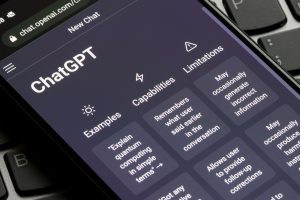Image Credit: Photo by Chris Montgomery on Unsplash
Since the public release of the AI chatbot ChatGPT, it has garnered a lot of curiosity and media attention. It heralds a tremendous advancement of artificial intelligence technologies, especially in the area of natural language processing. And though not primarily geared towards it, one of the key fields that ChatGPT has shaken up and raised important questions in is education.
An Upheaval in Education
Over the last few years, the field of education has undergone a great deal of tumult. The COVID-19 pandemic in 2020 suspended in-person learning, provoking a wide scale shift to online platforms. Before this, newer technology was, of course, being integrated into education. However, the sudden and massive move pushed an accelerated adoption of a slew of technological and online tools. Complaints about having to adjust to the “new normal” in such a short period of time aside, concerns arose about the effects of the monumentally increased screen time for students who already live in an age of online distractions and shortening attention spans.

ChatGPT has been the subject of much media and public attention since its release in November 2022.
Image Credit: © Tada Images / Adobe Stock
The fact that the intensity of the pandemic rose and fell in waves ensured that the return of students and teachers to classrooms was slow and uncertain. Even as things appeared to have finally settled down, the release of ChatGPT in the concluding months of 2022 has acted as another disruptor to the education system currently in place.
Long-form written assignments, such as essays and papers, have long been a mainstay of assessment in education. The gradual adoption of the internet as a resource for learning has certainly had a transformational effect on the way these assignments were completed, from access to a wider range of information for research purposes to online writing tools. However, ChatGPT’s capabilities provide students with an AI option that allows them to completely bypass the entire writing process. As some of them use the chatbot to generate entire essays, questions about academic integrity, creativity, and a loss of learning are being asked.
Teaching with AI and ChatGPT
Students are, of course, not the only group affected by these fast-paced changes; teachers are equally subject to them. The end goal of the profession might remain the same—to educate. However, the rest of the landscape and the ways they can effectively achieve that goal are rapidly altering. This is mainly due to the leaps-and-bounds advancements in technology taking place every few years.

The manner in which teaching takes place has transformed over the course of the last few years.
Image Credit: Photo by Pixabay
In education, any advancement in technology is eyed with disquiet. But it is also a coin with two sides—it has its advantages as well as disadvantages. The same is true for AI. ChatGPT and similar conversational AI tools have raised an alarm over what they spell for the future of learning and assessment. This has even led to bans being instituted against ChatGPT on several school and college campuses around the globe.
The issues with the way some students are using ChatGPT are apparent. They are turning in assignments without availing themselves of the actual benefits of researching and writing them. At the same time, these papers may contain bias and other misinformation that AI has convincingly framed as fact. While errors such as these may be inadvertent on the part of ChatGPT, they are not really aiding students either.
Plagiarism is a tough problem to tackle, and the arrival of AI-generated content on the scene further complicates matters. While the race is on, so far, consistently accurate detectors for such content have not yet been developed. And it is likely to get harder as AI’s language abilities grow. This puts educators in a tough position as written assignments as a means of assessment may become obsolete.
Concerns such as these paint AI tools, like ChatGPT, in a bad light and justify the backlash against it.
Integrating AI Tools in Education
On the other hand, AI is most likely going to be an essential aspect of the future of humanity. Attempting to prevent students from accessing and using it over the long term is not sustainable and, even if achieved, would be problematic. Thus, some teachers are turning towards ChatGPT rather than turning their backs on it.
The large database of information it has access to along with its ability to collate and present information in a short amount of time makes it a valuable resource for research (its output should, however, be verified). This comes handy in interactive classrooms for both teachers and students.
Teachers can also generate lesson plans and outlines on the chatbot. This provides them with a reasonable base with which to begin planning their classes while also cutting down the amount of time they have to spend on it.

The existence of AI technology ensures that it will eventually be integrated into the classroom.
Image Credit: © Art Gallery / Adobe Stock
Similar administrative tasks that teachers routinely have to perform, such as composing emails to students and parents, can now be easily automated with ChatGPT freeing up more time and mitigating some of the burnout they experience.
Other applications of AI in education that are being considered include using it as a means to personalize learning for students (especially those with different means) and as an assessment tool for providing feedback.
Meanwhile, the problems with AI bias and ethics remain, as do concerns about equity and equal access (students and teachers in areas that are technologically less developed may not have access to AI as much as their counterparts in more advanced areas). Transparency regarding the data used to train AI too remains a glaring issue. However, as AI seeps into the mainstream, these challenges are attracting more and more public attention. In the future, AI that is now privately managed is likely to be subject to regulation that addresses these and more obstacles.
The upheaval that ChatGPT has caused in education is today leading to panic. However, the chatbot opens the door to a wider integration of AI technologies into education and learning.
